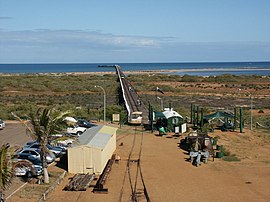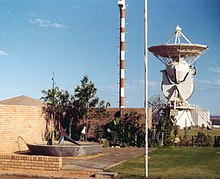Carnarvon, Western Australia
| Carnarvon Western Australia | |||||||||
|---|---|---|---|---|---|---|---|---|---|
 Carnarvon jetty | |||||||||
| Coordinates | 24°52′02″S 113°39′40″E / 24.86722°S 113.66111°E | ||||||||
| Population | 4,426 (2016 census)[1] | ||||||||
| Established | 1883 | ||||||||
| Postcode(s) | 6701 | ||||||||
| Elevation | 4 m (13 ft) | ||||||||
| Location | |||||||||
| LGA(s) | Shire of Carnarvon | ||||||||
| State electorate(s) | North West | ||||||||
| Federal division(s) | Durack | ||||||||
| |||||||||
Carnarvon is a coastal town about 900 kilometres north of Perth, Western Australia. It is at the mouth of the Gascoyne River on the Indian Ocean. The popular Shark Bay World Heritage Site lies to the south of the town. In 2006, there were 5,283 people living in Carnarvon.[2]
History[change | change source]
The town began in 1883, as a port and supply centre for the surrounding region. It is the administrative centre for the Shire of Carnarvon, the town site was officially listed on 4 June 1891. It was named after Henry Herbert, 4th Earl of Carnarvon, Under-Secretary of State for the Colonies.
Tramways[change | change source]
Carnarvon has had three tramways.[3]
- The first, shown on a Public Works Department map of 1884, ran from a landing site on the river, across Olivia Terrace to a shed on the other side of the road. This was only a very short distance. The trolley used on this tramway was hand powered, using a lever attached to crank on two of the wheels. However, there is a reference to the use of wind-power.
- The second tramway, built between 1886 and 1887, ran west from Cleaver Terrace in a straight line to the jetty, which was half way between Mangrove Point and Conspicuous Clump. It was pulled by horses.
- The third tramway was completed on 9 November 1900. It runs from the town, across Babbage Island to the deep-sea jetty. It was built with a rail gauge of 2 feet (610 mm). It was 3.3 kilometres (2.1 mi) long. Due to the heavy loads of wool being carried on what was a very light railway, it was decided to change the tramway to 3 feet 6 inches (1,070 mm) gauge in 1908-1909. This tramway used a steam locomotive. The tramway closed in 1965. The Carnarvon Light Railway Association now operates trains along restored tracks on the jetty.
Climate[change | change source]
Carnarvon has a warm to hot dry climate. Average yearly rainfall is 226 millimetres (8.90 in) with the rainiest months being in May and June. Occasionally tropical cyclones will influence Carnarvon and bring very heavy rain, high temperatures and strong winds. Apart from possible cyclones, summers are usually dry. Temperatures range from an average maximum of 33 °C (91 °F) in February to 22 °C (72 °F) in July. Average minimums are 23 °C (73 °F) and 11 °C (52 °F) respectively.
Main industries[change | change source]
Main industries of the area include:
- mining, at a salt mine on nearby Lake MacLeod and at inland mines.
- agriculture, particularly bananas, as well as tomatoes, wool, cattle, sheep and goats.
- fishing (especially prawns)
- tourism.

During the 1960s, NASA set up the Carnarvon Tracking Station to support the Gemini and Apollo space program. The tracking station was closed in the mid 1970s. Only the foundations of this historical site remain.
Radio Australia had a shortwave relay station (built during the 1970s) that used to relay programming to Europe, South Asia and South East Asia.
Education[change | change source]
There are five schools in the town, three government-run and two independent. These schools are: St Mary's Star of the Sea Catholic School which was built in 1906, Carnarvon Senior High School, East Carnarvon Primary School, Carnarvon Primary School, Carnarvon Christian School and Carnarvon School of the Air.
Rocketry[change | change source]
In 1964 and 1965, 12 rockets were launched from Carnarvon to a maximum altitude of 120 kilometres (390,000 ft).[4]
Korean Star[change | change source]
On 20 May 1988, the bulk carrier Korean Star ran aground in bad weather near Cape Cuvier, within the port limits of Carnarvon. Around 600 tonnes of fuel oil were spilled into the ocean. Damage was limited to 10 kilometres (6.2 mi) of remote beaches and coastline. The ship was left grounded, however very little of the wreck remains to be seen.
References[change | change source]
- ↑ Australian Bureau of Statistics (27 June 2017). "Carnarvon (L) (Urban Centre/Locality)". 2016 Census QuickStats. Retrieved 5 January 2018.
- ↑ Australian Bureau of Statistics (25 October 2007). "Carnarvon (Urban Centre/Locality)". 2006 Census QuickStats. Retrieved 2008-10-02.
- ↑ Rogers, Phillipa. Carnarvon's Tramways: A History Australian Railway Historical Society Bulletin, August, 1999 pp296-307
- ↑ "Encyclopedia Astronautica Index: 1". www.astronautix.com.

